„INSERT DISC: a digital flaneur’s guide“
Extensive post on Rhizome about INSERT DISC. Thx Ben!! 🙂
http://rhizome.org/editorial/2012/oct/2/insert-disc-digital-flaneurs-guide/
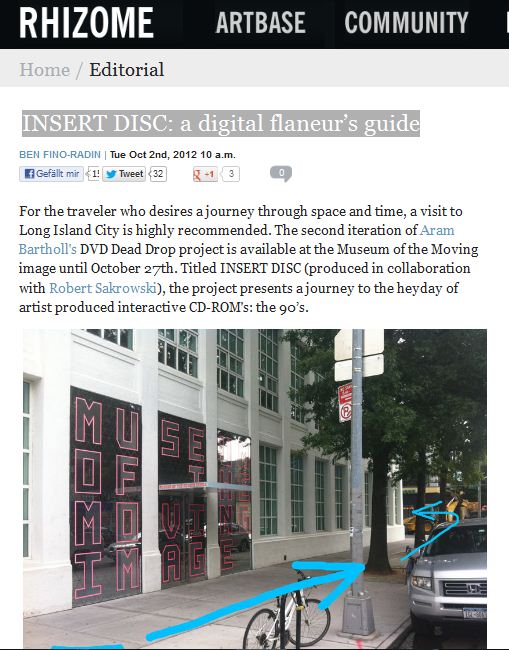
Die Ausstellung Decoding the Black Box bringt Künstlerinnen und Künstler zusammen, die Licht in diesen dunklen Raum und die Prozesse werfen, die sich in ihm ereignen. Sie legen dabei nicht nur die Funktionsweisen digitaler Technologien wie beispielsweise von künstlicher Intelligenz offen, sondern visualisieren zugleich die Auswirkungen, die sie auf unsere Wahrnehmung von Realität und unser In-der-Welt-Sein haben. Während sie die ökonomischen und machtpolitischen Strukturen der digitalen Technologien und insbesondere des Internets transparent machen, zeigen sie Gegenentwürfe für eine dezentralisierte, humanere und demokratischere Nutzung ebendieser auf.
14:00 – 16:00
Killyourphone is an open workshop format. Participants are invited to make their own signal blocking phone pouch. In the pouch the phone can’t send or receive any signals. It is dead! This workshop was run for the first time at the Chaos Communication Congress in Hamburg end of 2013.
Monday 25th of March, 7:00 PM at Web Cafe, Eptanisou 40, 113 61 , Kypseli – Athens
with:
!Mediengruppe Bitnik with Selena Savić & Gordan Savičić , Ingrid Hideki, Joanna Bacas, Kyriaki Goni, Maria Mavropoulou, Marina Gioti, Marsunev, Nadja Buttendorf, Theo Triantafyllidis
Curated by Aram Bartholl & Socrates Stamatatos
Speed Show lands in Greece, the country of souvlaki, the sun (yes we can claim that they originated a celestial body), ouzo, feta, an enormous financial debt. Currently, Greece is also trending for all the wrong reasons namely, gentrification, queerphobia, state crimes and more dystopic incidents.
As 2024 unfolds, we find ourselves amidst a whirlwind of confusion, bombarded with a cacophony of online horrors to consume, an attention span further abbreviated by TikTok’s algorithm and the barrage of incoming stitches.
Stitches Incoming serve as a conduit for creators to engage and converse, traversing from one topic to the next. They have evolved into a new social fabric, weaving connections within an ever-shifting digital and physical landscape while also serving as a testament to personal and collective traumas, both past and present.
What unites the participating digital artists? Perhaps everything and nothing simultaneously… Departing from the traditional Speed Show setup, where artworks are carefully stacked inside internet cafe computers, and drawing inspiration from the structure of TikTok stitches, each piece seems to propel the conversation forward, or perhaps uses the next as a springboard for its own narrative.
Stitch this and stitch that, we have everything you ever wanted (maybe) ! Are we stuck in an infinite loop of sh*tposting, valuable content, the highlight of social issues, personal and interpersonal experiences?
Maybe! Come and find out…
More info on Speed Shows at https://speedshow.net/stitch-incoming/
14:00 – 16:00
Killyourphone is an open workshop format. Participants are invited to make their own signal blocking phone pouch. In the pouch the phone can’t send or receive any signals. It is dead! This workshop was run for the first time at the Chaos Communication Congress in Hamburg end of 2013.
14:00 – 16:00
Killyourphone is an open workshop format. Participants are invited to make their own signal blocking phone pouch. In the pouch the phone can’t send or receive any signals. It is dead! This workshop was run for the first time at the Chaos Communication Congress in Hamburg end of 2013.
Extensive post on Rhizome about INSERT DISC. Thx Ben!! 🙂
http://rhizome.org/editorial/2012/oct/2/insert-disc-digital-flaneurs-guide/

We are very excited to present INSERT DISC. It was a great adventure to travel back in time to free sunken art treasures
guarded by Moore’s monster octopus on a sunken MacOS7.We hope you will enjoy this travel as we did! Get the DISC at MMI, NYC, any time, for FREE!
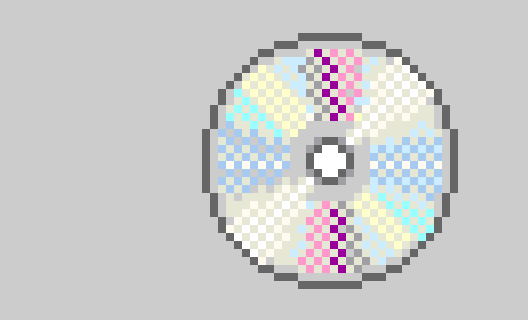
September 22 – October 27, 2012
at DVD Dead Drop, Museum of Moving Image NYC
curated by Aram Bartholl & Robert Sakrowski (curatingyoutube.com)
The second DVD Dead Drop volume INSERT DISC, features several classic art CD-ROMs from the mid-90s on DVD. While the web was still in its infancy, artists from a wide range of fields explored the possibilities of interactivity and multimedia on CD-ROMs, fancy new silver discs that held an unbelievable 650 megabytes of data. Today most of these pre-web multimedia works are no longer accessible because they require legacy operating systems and software to run. INSERT DISC offers the full experience of a cutting edge, mid-90s operating system packed with stunning multimedia art. Each DVD comes with a safe-to-install virtualized Ubuntu Linux operating system running an emulated Mac OS 7.6. In addition to the historic CD-ROM art, special features include historic browsers, link lists, and more, guaranteeing a true 1995 computer experience!
artist/projects:
Anti Rom
SASS Collective: Andy Allenson, Joel Baumann, Andy Cameron, Rob LeQuesne, Luke Pendrell, Sophie Pendrell, Andy Polaine, Anthony Rogers, Nik Roope, Tom Roope, Joe Stephenson, Jason Tame
CD-Rom, 1995
Manuscript
Eric Lanz, CD-Rom 1994
Cyberflesh Girlmonster
Linda Dement, CD-Rom 1995
User Unfriendly Interface
Josephine Starrs & Leon Cmielewski, first shown 1994, CD-Rom 1996
——————————————————————————————————————————————————
Extra 90’s specials:
Browser collection, ‘Einblicke ins Internet’ offline Internet CD-Rom, Bookmark easter eggs & more
credits:
Andreas Broeckmann, Sandra Fauconnier, nbk Berlin, ZKM Karlsruhe, Transmediale archive
——————————————————————————————————————————————————
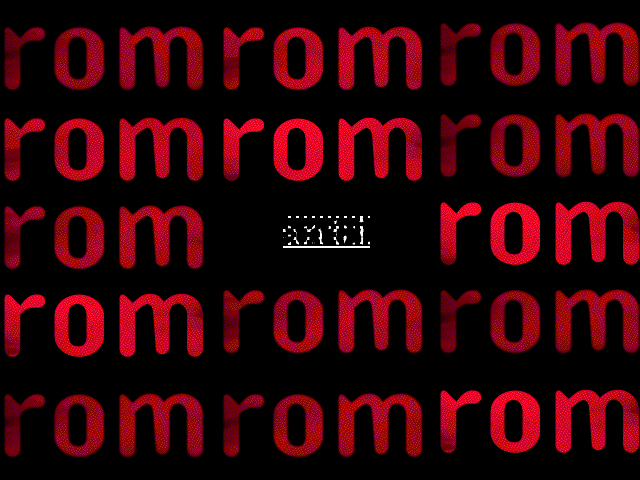
Anti Rom
1995, CD-Rom, http://www.antirom.com/
SASS Collective: Andy Allenson, Joel Baumann, Andy Cameron, Rob LeQuesne, Luke Pendrell, Sophie Pendrell, Andy Polaine, Anthony Rogers, Nik Roope, Tom Roope, Joe Stephenson, Jason Tame
self-published and funded by the Arts Council of Great Britain.
“Offering a highly interactive interface to the collected sounds and images, this work is an exploration of the limits of what the CD-ROM medium can actually handle. Andy Cameron: „Antirom offers a radical critique of the poverty of contemporary multimedia in a number of savagely ironic, absurdist and incisive satires. Antirom is specifically against the ill conceived grafting of point-and-click functions onto traditional linear forms. Antirom is for the development of a new language of representation, and new modes of spectatorship, within the new apparatus of interactivity.“ http://www.v2.nl/archive/works/antirom
[ http://www.antirom.com/
——————————————————————————————————————————————————
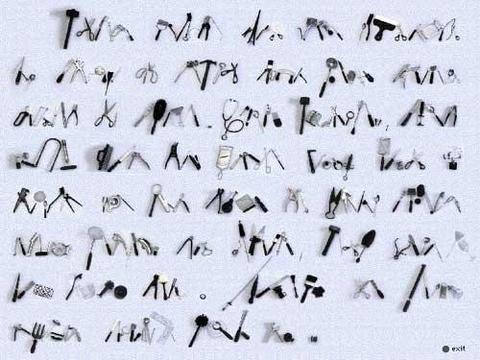
Manuscript
Eric Lanz, 1994, http://www.ericlanz.net/
CD-Rom, Macromedia Director Apple QuickTime
Production: ZKM | Institute for Visual Media, 1994.
“A text, displayed in a linear way but made out of visual characters of tools, is activated by a mouse-click on an icon and plays back a four second video sequence with the actual use of the tool. The title refers to the iconography of each letter as well as to the origin of language in so far as it is related to manufactured objects, i.e. here a page ‹written› by hand and set in motion by the user’s hand.”
Rudolf Frieling – http://at.zkm.de/node/270
——————————————————————————————————————————————————
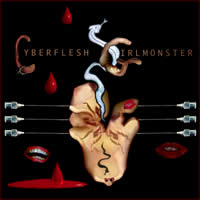
Cyberflesh Girlmonster
Linda Dement, CD-Rom 1995, http://www.lindadement.com/
Australian Network for Art and Technology, Australian Film Commission
“Donated body parts collected during Artists‘ Week of the Adelaide Festival 1994 have been used to construct a computer based interactive work. About 30 women participated in the original event by scanning their chosen flesh and digitally recording a sentence or sound. Conglomerate bodies were created from the information donated. These have been animated and made interactive. When a viewer clicks on one of these monsters, the words attached to that body part could be heard or seen, another monster may appear, a digital video could play, a story or medical information about the physical state described by the story, may be displayed. The user moves relatively blindly between these. There is no menu system or clear controllable interface. The work is a macabre, comic representation of monstrous femininity from a feminist perspective that encompasses revenge, desire and violence.[…]” http://www.v2.nl/archive/works/cyberflesh-girlmonster http://www.newmediacaucus.org/html/journal/issues/html_only/2006_spring/Sp06_Davis.htm
——————————————————————————————————————————————————
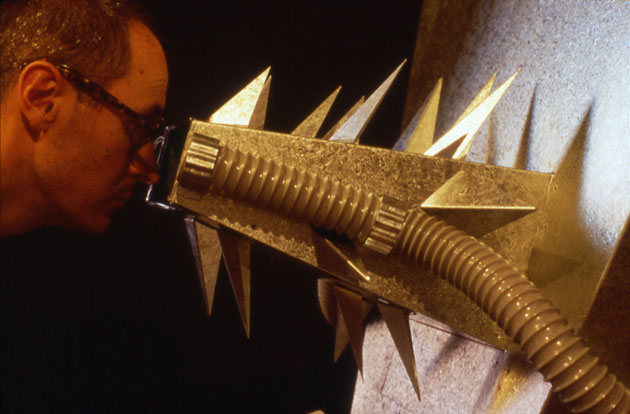
User Unfriendly Interface
Josephine Starrs & Leon Cmielewski, first exhibited 1994, CD-Rom published 1996. http://lx.sysx.org/
Produced with the assistance of the Australian Film Commission
User Unfriendly Interface, CD ROM/Installation on themes of conspiracy theories, male vs female concept of space, dating services, mens issues & personality testing. 1997 Video Positive, Liverpool, UK “Since 1994 we have collaborated on a variety of new media arts projects that incorporate interactivity and play as strategies for engaging with the social and political contradictions inherent in contemporary society. Audience engagement is a vital element in our interactive artworks. We sometimes think of our work as performance art, were the artist is not physically present; the actions of the performer are programmed into the work, with the viewers’ response completing the piece. We have closely observed how viewers interact with our work, and have drawn on these observations in the creation of each subsequent piece. […]”http://scan.net.au/scan/journal/display.php?journal_id=100